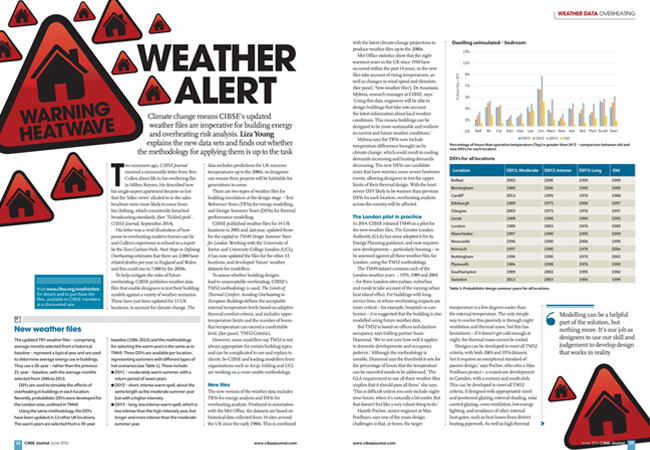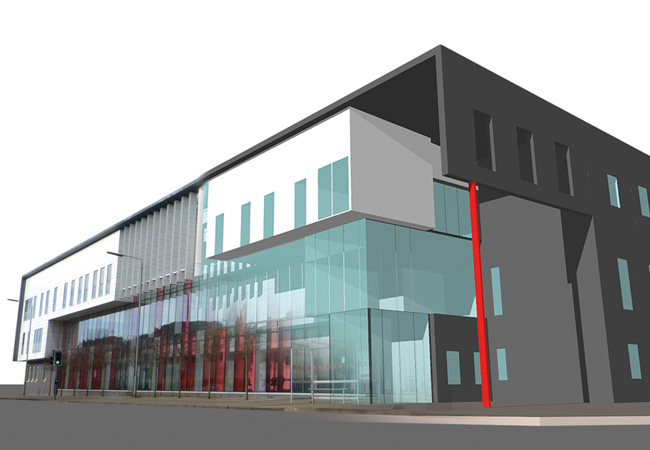
From CIBSE Journal, June 2016
A suitable approach
The issue of overheating (‘Weather alert’, CIBSE Journal, June 2016) is clearly a topic raising much discussion in both the popular and technical press.
Unfortunately, there does seem to be a common misconception in the industry about the overheating criteria that thermal models are to be assessed against. The ‘Weather alert’ article continues this.
The issue arises out of the application of the ‘adaptive’ approach, which is put forward in both TM52 and CIBSE Guide A 2015. There seems to be a general impression that the adaptive approach can be arbitrarily chosen over the more ‘traditional’ fixed temperature (usually around 26oC). In fact, a building must be suitable for the adaptive approach to be used. This is clearly defined in BS 15251 Indoor environmental input parameters for design and assessment of energy performance of buildings addressing indoor air quality, thermal environment, lighting and acoustics.
As an industry, it is important to make sure we are using the correct measure for defining overheating
Annex A2 states a number of criteria that have to be satisfied, the most notable being that occupants must have the option of easy access to opening windows that have a significant effect on the thermal environment. So a space that is mechanically ventilated (without opening windows, perhaps for acoustic reasons), or that only has nominally openable windows, is not suitable for the adaptive approach and the traditional fixed temperature criteria must be used.
Unfortunately, the CIBSE guidance (which refers back to BS 15251) about the applicability of the correct criteria is unclear. The matter is probably also confused by the fact that BS15251 sees fit to define any mechanical ventilation using a fan as ‘mechanical cooling’, in the same way as if a chiller were installed. This means that a mechanically ventilated building cannot be ‘free-running’.
I agree that we do not want to get to the stage where there is no option other than mechanical cooling – which most people would consider to include a chiller or similar – but, as an industry, it is important to make sure we are using the correct measure for defining overheating.
Nick Hart MCIBSE
CIBSE research manager Anastasia Mylona, replies:
CIBSE is aware of this issue of defining free-running buildings for application of TM52 criteria in overheating analysis, especially in the domestic sector.
CIBSE’s Homes for the Future Special Interest Group is working on a clarification of the definition, which it is hoping to publish in the new technical memorandum (TM) Good practice in the design of homes.
A draft summary of the group’s advice is as follows:
‘It is proposed that for clarification, the forthcoming CIBSE TM Good practice in the design of homes should advise:
- Homes that are predominantly naturally ventilated, including homes that have MVHR with good opportunities for natural ventilation in the summer, should assess overheating using the adaptive method described in CIBSE TM52. To allow the occupants to “adapt”, each habitable room needs openable windows with a free area that satisfies Building Regulation Part F “purge” ventilation criteria – that is, the window opening area should be at least 1/20th of the floor area of the room (different conditions exist for windows with restricted openings). Further advice on the assessment method is given in TM52.
- Homes that are predominantly mechanically ventilated, including homes with MVHR that have no opportunities – or restricted opportunities – for opening windows, should assess overheating using the fixed temperature method. The rooms should not exceed an operative temperature of 26oC in the summer for more than 3% of the occupied hours.
Care homes and accommodation for vulnerable occupants, or where external background noise would be unacceptably high when windows are open, should use the fixed temperature method. Further advice is given in CIBSE Guide A, 2015.’
- CIBSE Journal welcomes readers’ letters, opinions, news stories, events listings, and proposals for articles.
Please send all material for possible publication to: editor@cibsejournal.com or write to: Alex Smith, editor, CIBSE Journal, CPL, 1 Cambridge Technopark, Newmarket Road, Cambridge CB5 8PB, UK. We reserve the right to edit all letters.



